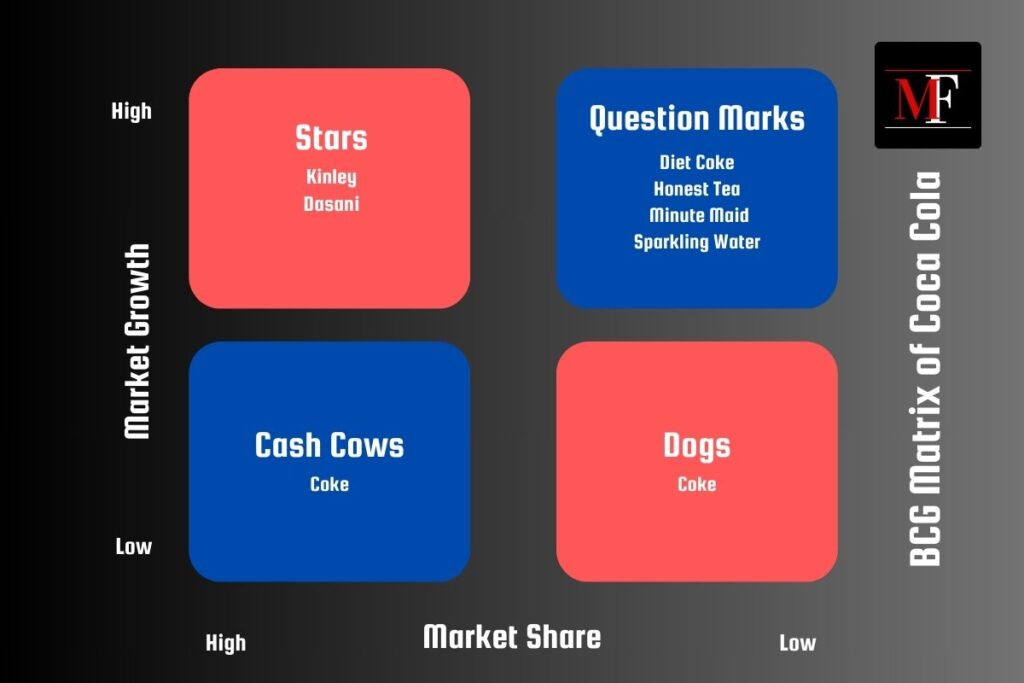Businesses across different sectors employ different marketing methods to promote their products and services and boost sales. One such approach is the BCG matrix, which has been helping companies since 1968 in evaluating their product portfolio and refining their business strategies.
Coca Cola, with its diverse range of products, utilizes its own BCG Matrix to measure its position in the market. While Coke is well-known, it is just one of many products assessed within the matrix. Let’s have a look at the BCG matrix of Coca Cola after a brief introduction of the company.
Coca Cola Background
The Coca-Cola Company began its operations in the late 1800s when John Smith Pemberton created it as a medicine. However, it was Asa Griggs Candler‘s efforts in the 1900s that made Coca-Cola popular as a soft drink. This journey shows how the product changed from a medicine to a well-known beverage.
Although many people recognize the taste of Coca-Cola, its recipe is a secret. The company makes concentrates, which they sell to licensed distributors worldwide. These bottlers (with exclusive contracts) mix the concentrates with sweeteners and filtered water to make drinks in bottles and cans.
These bottlers then sell Coca-Cola to restaurants, stores, and vending machines. They can also sell concentrates to food service retailers and big soda restaurants. Instead of making cans and bottles themselves, Coca-Cola sends its drinks to licensed manufacturers globally.
Analysis of BCG Matrix of Coca Cola

Just like the other companies, Coca Cola BCG matrix also comprises of four quadrants. Let’s have a look at them.
Stars
Stars in the BCG matrix of Coca Cola are the products that are doing really well in the market and are growing fast. While many people think Coca-Cola’s best-selling product is its soft drinks, actually, a bottled water brand is the real star.
Kinley and Dasani are both among Coca-Cola’s top products, and they fall into the “Stars” section of its BCG matrix. These are the leading bottled water brands from Coca-Cola, and they are popular in different parts of the world.
Kinley is popular in Europe, while Dasani is liked more in the United States. That is because more people are looking for healthier drinks, the “Star” category in Coca-Cola’s BCG matrix predicts the company will reach even more customers. This also means Coca-Cola is more likely to invest more in these products.
Question Marks
In the BCG matrix, the “question mark” segment represents products and services that are in the developmental stage. These are yet to make a significant impact on market reach, sales, and profits. However, they show promise and could lead to broader market opportunities if managed effectively.
In the Coca Cola BCG matrix, Diet Coke, Honest Tea, Minute Maid, and Sparkling Water fall into the question mark category. These are recently introduced drinks by Coca-Cola that target the expanding market of consumers seeking non-carbonated beverages. Due to the increasing focus on healthier lifestyles, many people are inclined towards healthier drink options.
Cash Cows
Coke holds the title of “Cash Cow” in Coca-Cola’s BCG matrix as it leads the market and brings in massive amounts of revenue for the company. Coke is basically everywhere: you can find it in vending machines, restaurants, fast food outlets, supermarkets, and households.
Although cash cows have slower market growth, they still generate considerable revenue. Products in this segment have firmly established their place in the market, requiring continued investment to maintain profitability.
However, companies need to be cautious with cash cows, as they may become less significant if demand and market conditions shift.
Dogs
Dogs represent products with limited growth potential and modest market and growth share. Certainly, Coca Cola’s premier product, Coke, has played a significant role in the company’s market success. However, interestingly, within the Coca Cola BCG matrix, Coke is also classified as a “dog.”
With the increasing popularity of healthier alternatives, there is an expected decline in carbonated soft drinks, including Coke. If this trend continues, Coke, currently categorized as a cash cow in the matrix, may permanently transition into the dog quadrant. While there will still be consumers of Coke in the future, it’s likely to be fewer than in previous decades.
Also read PepsiCo BCG Matrix.
Summing it up
The Coca-Cola BCG Matrix serves as a valuable tool for businesses aiming to introduce beverages to the market. Coca Cola BCG matrix has also taught us that a single product may fall into two different quadrants of the BCG matrix at the same time.
Creating the matrix is straightforward, requiring only the completion of four segments. However, it’s essential to fully understand all quadrants to provide accurate details on the BCG matrix diagram.
